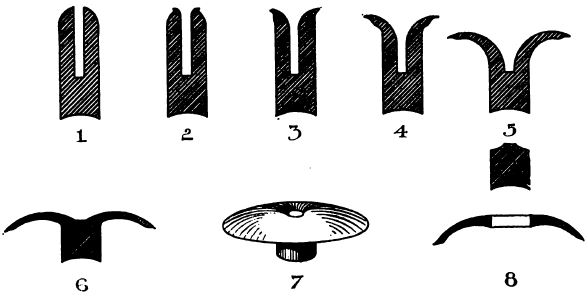
Bullets Versus Snow by Major Isaac Arnold, Jr., Ordnance Dept., U. S. A.
Journal of The Military Service Institution, vol VII, No. 52, July 1891
RECENTLY my attention has been called to articles in newspapers in regard to Russian experiments upon snow as a suitable substance from which to improvise breastworks in time of need.
Eight or nine years ago, I made some experiments at Indianapolis Arsenal that had for their object the determining the action of express bullets when fired into soft substances. By "express" bullet is meant a hollow pointed projectile filled with beeswax or other substance that will assume the fluid form when fired from a rifle.
The express bullets used were formed by placing service bullets (cal. 45) in a lathe and boring a hole about one-tenth of an inch in diameter along the longer axis, two-thirds the length thereof, after which the cavity so formed was filled with melted beeswax.
I found the penetration in loose snow, using the Springfield rifle with service charges of powder and the service bullet, range thirty feet, was a little less than seven feet. The snow was confined in sections of stovepipe, a piece (sheet) of thin manifold paper being placed between sections as a telltale to show which section contained the bullet. These sections of paper showed upon examination that a cone of snow with a constantly increasing base (until penetration ceased) had been formed on the point of the bullet, and I concluded that the slight penetration was due to this constantly increasing surface of resistance. The force stored up in the service bullet was gradually taken up, for, on recovery, the bullets showed no signs of disfiguration.
Service bullets altered to express bullets as described and fired with service charges of powder (70 grains), had about the same penetration, but the bullets had undergone a complete change of form. When recovered they resembled mushrooms in appearance. When bullets were fired into snow with charges of five grains of powder there was little penetration. The effect on the bullet was a barely perceptible opening of the cylindrical hole whose axis was coincident with the axis of the bullet, the enlargement being near the point of the bullet. Successive increase of the charges by five grains each, resulted after a while in a complete change of the cylindrical opening into one resembling a cone whose base was at the point of the bullet and apex near the base of same. Increasing the charges by five grains each from this on, the bullets gradually opened out at the point and the expanded metal, rolling outwards and back towards the base, formed a mushroom head. With maximum charges of powder (all the cartridge case would hold) the base of the bullet passed through the head, and was found imbedded in the snow a few inches in advance of the same. It appears that a part of the force stored up in the bullet was expended in changing the form thereof, and undoubtedly the same action takes place when bullets of this kind are fired into the bodies of animals, and accounts for their great destructive effect.
When express bullets are fired with service charges of powder, it is assumed that the beeswax melts and becomes a column of fluid, confined under great pressure. This being the same in all directions, change of form begins along the lines of least resistance, which at first are located near the point, in directions normal to the longer axis of the bullet, and later these lines of resistance become sensibly parallel with the same, thus accounting for the disfiguration or change of form of the bullet. The sketches numbered from one to eight illustrate graphically the action of these bullets under the conditions described, they being ideal sections made by an artist after reading this description.

As the slight penetration of the service bullet with service charges of powder is undoubtedly due to the constantly increasing surface of resistance resulting from the formation of the cone of snow on the point of the bullet, it is believed that loose snow containing a large per cent, of moisture, so that it will pack freely or make good snowballs, would be best suited for use in case of need. A snow fort, properly constructed, would afford complete protection against infantry fire at all ranges if they were armed with our service rifle.
Clean sawdust possesses in a high degree the property of snow to resist penetration of projectiles of small calibre; in fact, the penetration is substantially the same for each. Bullets fired into sawdust will suffer no disfiguration except that due to the presence of foreign substances, such as sand or grit. The sawdust should be well screened and loosely confined or thrown together, not packed tight, so as to allow freedom of movement of the particles to aid the formation of the cone on the point of the bullet. In my experiments the snow was passed through a screen and allowed to fall into a section of pipe, care being taken not to shake the pipe nor pack the snow. When filled, the sections were handled and put together with care to avoid any packing of the contents.
It has occurred to me that butts filled with sawdust might be utilized to receive the bullets at gallery practice, from which they might be recovered and again used without remoulding.
It would be interesting to know the actual penetration of the small calibre steel coated bullets, with their high velocities. Should the law of penetration hold good with them, could not penetration in sawdust or snow be used as a standard of comparison for the value of all small arms intended for military service?